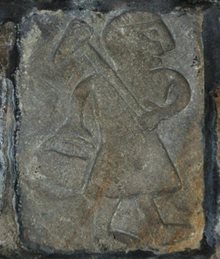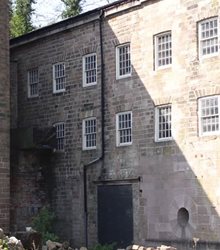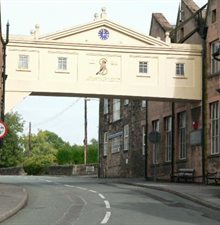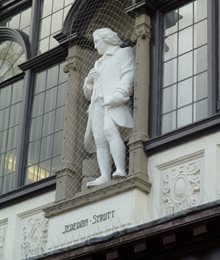Industrial Connections
The money that enabled the Nightingale family to become part of the nineteenth century liberal intelligentsia, and which financed Florence Nightingale’s life of unpaid public service, came from Derbyshire industry. The key figure in creating the Nightingale fortune was the second Peter Nightingale (1736-1803), who on his death left his money to his nephew William Shore, from Tapton near Sheffield. Shore was Florence Nightingale’s father – he changed his surname to Nightingale in 1815 as a condition of the inheritance.
Many of the details on this page are taken from the book Cromford Revisited by Dorenn Buxton and Christopher Charlton, published by Derwent Valley Mills in 2015, and from a 2015 paper on Peter Nightingale’s mill in the Derbyshire Archaeological Journal by Professor Stanley Chapman.
Lead Mining
Although the area around Cromford & Lea is now best known for its historical connections to the cotton spinning industry, it also has a much older history in lead mining. This industry employed the majority of the non-agricultural workforce in the area by 1750, and was the main source of wealth for prominent non-aristocratic local families. The industry was described in Daniel Defoe’s travel writing about the area in the 1720s.
Soughs to drain away water, and thus permit mining work, were constructed around Cromford from the 17th century onwards, the first planned in 1631 by the Dutch engineer, Cornelius Vermuyden. In 1657-8, the Cromford Long Sough was constructed using gunpowder to blast away rock.
Peter Nightingale’s wealth, like that of his local peers, was derived from this industry. By the 1770s, he had amassed a fortune sufficient to purchase substantial amounts of local land and to diversify into other areas, such as finance and the nascent cotton industry. He was also sufficiently prominent to become High Sheriff of Derbyshire for 1769-70.

Anglo-Saxon image of a lead miner, found at Bonsall, near Cromford, in the 19th century. Wikimedia Commons, CC BY-SA 2.0

Arkwright's 1771 mill in Cromford. Public domain.
While Peter Nightingale was well established in Derbyshire industry and society before the beginning of the Industrial Revolution, Richard Arkwright (1732-1792) was a newcomer, from Preston via Nottingham. He chose Cromford for the site of his cotton mills because of the reliable water supply from the mining soughs, and perhaps also as a place where he could easily become socially prominent - he'd found the high society of Nottingham tough to penetrate.
When Arkwright built his second, larger mill at Cromford in 1776, Peter Nightingale provided part of the funding. Nightingale also provided financial assistance to help Arkwright to obtain the Manor of Cromford and Willersley, where he built Willersley Castle in the 1790s.
Arkwright’s mills, as the first to produce cotton using a factory system, were initially extraordinarily profitable, and attracted a new population of workers to the area – his mills employed over 1,000 people by 1782. In this initial phase Arkwright particularly sought child labourers. A school opened by Arkwright had 200 pupils by 1785.
Perhaps in view of Arkwright’s enormous profits, Peter Nightingale decided to set up his own cotton mill a couple of miles away, at Lea Bridge. Construction began in 1783. It cost £800 to build, with the machinery and stock insured for £1000. Nightingale recruited one of Arkwright’s skilled workmen, Benjamin Pearson, to provide the technical expertise. This however resulted in an argument with Arkwright, who launched a lawsuit against Nightingale for patent infringement.
The mill nonetheless opened in 1784, with Nightingale placing an advertisement in the Derby Mercury for ‘good callicoe weavers … who may be accommodated with large houses and have employment for their children’.
Lea Mill did not get off to a great start. It was hit by severe flooding in 1785, and Nightingale put the site up for sale in 1786. However the mill was not sold, and control of it instead passed to Nightingale’s associate, John Smedley, whose successful stewardship led to his name eventually becoming synonymous with the mill. It nevertheless remained part of the Nightingale estate, and the Smedley family continued to pay the Nightingales substantial sums in rent until finally purchasing the site in 1894.
The mill and its workforce were a very significant part of the local landscape in Lea for the whole of Florence Nightingale’s lifetime. For Nightingale, the mill workers were a source of interest and concern, as well as an opportunity to practice philanthropy, understand the health challenges facing industrial workers and learn how to communicate effectively with them.

Lea Mills / John Smedley's mill. Having been in continuous operation since 1784, it has a claim to be the oldest continuously-operating factory in the world.
Wikimedia Commons, CC BY-SA 2.0.
Belper & the Strutts

Statue of Jedediah Strutt on the Boots Building, Derby - next to a statue of Florence Nightingale. Wikimedia Commons, CC BY-SA 4.0.
Jedediah Strutt (1726-1797) was a partner in Arkwright’s first cotton mill in Cromford, and in 1778 opened his own mill in Belper, eight miles to the south. Strutt and his son William (1756-1830) oversaw the transformation of Belper from a small hamlet of framework knitters to a significant industrial site.
In the nineteenth century the Strutts, as members of the liberal intelligentsia with a background in Derbyshire industry, had much in common with the Nightingales, and moved in the same social circles. There was a shared interest in healthcare – William Strutt had designed the Derbyshire General Infirmary in 1810, on the same principles of fireproofing that he had applied to the North Mill in Belper, rebuilt in 1804 following a major fire. The Strutts and the Nightingales had a further shared background in Unitarian Christianity.
Both families were also involved in Liberal politics. William Strutt's son Edward Strutt (1801-1880), known from 1856 as Baron Belper, was a Liberal MP for Derby (1830-48) and Nottingham (1852-1856). He briefly served as a minister around the time of the Crimean War. Baron and Lady Belper featured regularly on the Nightingales’ dinner party invitations lists.
See more:
Join our mailing list here